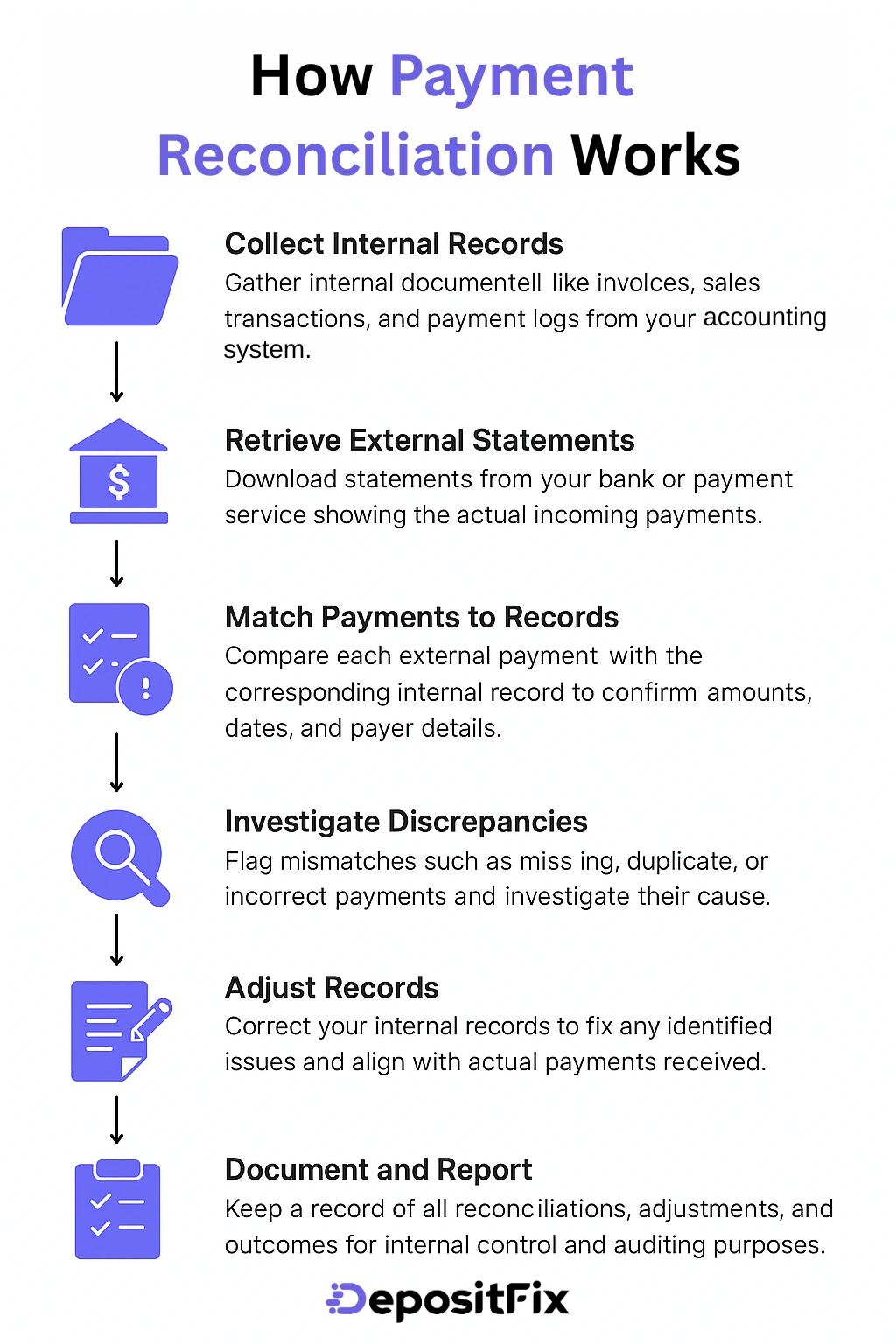Payment reconciliation is the process of comparing incoming payments recorded in your internal financial system with the transactions listed on external records such as bank statements, payment processor reports, or credit card statements. The goal is to ensure that all payments have been accurately received, recorded, and matched with the correct invoices or customer accounts.
This process identifies discrepancies such as missed payments, duplicate transactions, chargebacks, or accounting errors. Without proper reconciliation, businesses risk reporting inaccurate revenue figures, which can lead to poor financial decisions, tax reporting issues, and strained customer relationships.
For example, if a customer has paid an invoice but the payment is not properly matched in your system, it could appear as unpaid, triggering unnecessary follow-ups or even damaging your company’s reputation. Modern businesses often use automated reconciliation tools that integrate with accounting and payment systems to streamline this process, reduce human error, and provide real-time visibility into cash flow.
Whether handled manually or through software, payment reconciliation is a fundamental component of financial accuracy and operational transparency.
How Does Payment Reconciliation Work
Payment reconciliation involves systematically verifying that payments received match your financial records, such as invoices, sales transactions, or accounts receivable. The process helps ensure your books are accurate and up to date. It typically involves these steps:
- Collect Internal Records: Gather internal records such as sales invoices, accounting entries, and customer payment logs from your ERP or accounting software.
- Retrieve External Statements: Obtain corresponding bank statements, credit card processor reports, or payment gateway transaction logs that show actual payments received.
- Match Payments to Invoices: Compare each payment in the external statements with the relevant invoice or transaction in your internal system to confirm the amount, payer, and payment date match.
- Identify and Investigate Discrepancies: Look for differences like overpayments, underpayments, missing payments, or duplicate entries, and investigate the cause of each inconsistency.
- Adjust Records Accordingly: Make necessary adjustments to correct any accounting errors or update entries based on the investigation, ensuring everything aligns properly.
- Document and Report: Keep a detailed log of reconciliations performed, including resolved discrepancies, for auditing and reporting purposes.

Types of Payment Reconciliation
Payment reconciliation can vary depending on the payment channels and systems a business uses. Different types help businesses maintain financial accuracy across various transaction methods and platforms. Here are the main types of payment reconciliation:
- Bank Reconciliation: This is the most common type and involves matching your internal records with your bank statements to verify that all deposits, withdrawals, and balances align.
- Payout Reconciliation: This type ensures that all outgoing payments, such as vendor disbursements, refunds, or partner commissions, match the amounts recorded in your financial system and have been properly processed by the payment provider or bank.
- Merchant Account Reconciliation: Used by businesses that accept credit or debit card payments, this type compares transactions processed by the merchant service provider (such as Stripe or PayPal) with your sales records.
- Invoice Reconciliation: This process matches payments received with individual invoices issued to customers, ensuring that each invoice is paid in full and on time.
- Gateway Reconciliation: For businesses using payment gateways, this type verifies that payments reported by the gateway align with what’s recorded in your financial system.
- POS (Point-of-Sale) Reconciliation: Retailers use this method to compare sales and payments recorded at physical registers or POS systems with back-office accounting records and bank deposits.
- Cash Reconciliation: In businesses that handle cash payments, this type ensures that the physical cash on hand matches cash sales and expected deposits.
Each type of reconciliation targets a specific area of the payment process, and together, they help maintain comprehensive financial control across all channels.
Why Payment Reconciliation Is Important for Businesses
Payment reconciliation maintains financial integrity and operational efficiency in any business. When companies regularly verify that incoming payments match recorded transactions, they can avoid revenue leakage, detect errors early, and make informed decisions based on accurate financial data. It also supports compliance with accounting standards and regulatory requirements. The benefits of payment reconciliation include:
- Accurate Financial Reporting: Ensures your books reflect true revenue and cash flow, which is important for budgeting, forecasting, and decision-making.
- Fraud Detection: Helps identify unauthorized or suspicious transactions quickly, reducing the risk of financial loss.
- Improved Cash Flow Management: Gives real-time visibility into funds received, enabling better planning and resource allocation.
- Error Identification and Resolution: Catches data entry mistakes, duplicate payments, or missed invoices that could otherwise go unnoticed.
- Stronger Customer Relationships: Prevents billing disputes and payment errors that could damage trust or delay services.
- Audit Readiness: Maintains clean and traceable financial records, simplifying tax preparation and external audits.
- Operational Efficiency: Streamlines finance workflows, especially when supported by automation, saving time and reducing manual work.
Invoice reconciliation verifies invoices against purchase orders and receipts to ensure accurate billing, prevent errors, and approve correct payments efficiently.
Balance reconciliation ensures accuracy and matches internal records with external statements to detect discrepancies and maintain reliable financial data.
Cash reconciliation ensures all cash transactions match between internal records and bank statements, helping detect errors, fraud, or discrepancies.
Ready to streamline your payment operations?
Discover the hidden automation in your payment, billing and invoicing workflows. Talk to our experts for a free assement!

